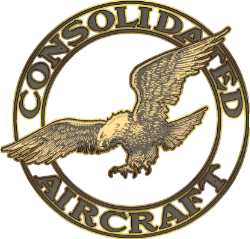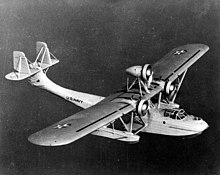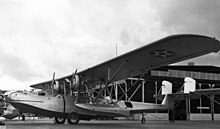.
History Consolidated / Convair
Consolidated P2Y-3 Model 9

The Consolidated P2Y was an American flying boat maritime patrol aircraft. The plane was a parasol monoplane with a fabric-covered wing and aluminum hull.
Initially created to compete for a U.S. Navy contract dated February 28, 1928, the prototype Model 9, XPY-1, was designed by Captain Dick Richardson and Isaac M. 'Mac' Laddon. Beginning construction in March 1928, the aircraft was ready for its first flight by the end of the year. Lieutenant A. W. Gorton made the first flight out of Anacostia NAS, Washington, D.C. The production contract was opened to other bidders, and the Glenn L. Martin Company undercut them and was awarded the contract to construct the plane as the Martin P3M-1 and P3M-2. Three P3M-1s and six P3M-2s were built;[4] one XP2M-1 was also built to a similar design, powered by three Wright Cyclone engines; following the removal of the third engine it was redesignated XP2M-2. The idea of a third engine on the XPY-1 had been studied and rejected by Navy Bureau of Aeronautics staff
Variants


Variants

A P2Y-3 of VP-43 at NAS Jacksonville in 1941 - XP2Y-1
- One prototype
- P2Y-1
- Navy version of the Commodore. 23 were ordered on July 7, 1931, and were delivered to Patrol Squadron 10
(VP-10) at Norfolk, Virginia on February 1, 1933. - P2Y-1C
- One aircraft delivered to Colombia in December 1932.
- P2Y-1J
- One aircraft delivered to Japan in January 1935.
- XP2Y-2
- One prototype
- P2Y-2
- Was a -1 with more powerful R-1820-88 engines faired into the leading edges of the wing. Other -1s were converted in 1936
0
KmCeiling
0
KmCombat RANGE
0
Km/hAircraft Speed
0
Max Crew
Photo Gallery
Consolidated / Convair / Vultee
Consolidated P2Y-3 Model 9


Consolidated Convair Vultee
Consolidated P2Y-3 Model 9
General characteristics
- Crew: five
- Length: 61 ft 9 in (18.82 m)
- Wingspan: 100 ft 0 in (30.48 m)
- Height: 19 ft 1 in (5.82 m)
- Wing area: 1,514 sq ft (140.65 m2)
Powerplant
- Empty weight: 12,769 lb (5,792 kg)
- Gross weight: 25,266 lb (11,460 kg)
- Powerplant: 2 × Wright R-1820-90 Cyclone radial piston , 750 hp (559 kW) each
Specifications
- Maximum speed: 149 mph (240 km/h
- Cruise speed: 118 mph (189 km/h,
- Range: 1,180 mi (1,899 km, 1,030 nmi)
- Service ceiling: 16,100 ft (4,265 m)
- Rate of climb: 650 ft/min (3.3 m/s)
Armament
- 1 × flexible bow-mounted .30 in (7.62 mm) M1919 Browning machine guns
- 2 × flexible dorsal-mounted .30 in (7.62 mm) M1919 Browning machine guns
- 2,000 lb (910 kg) bombload
.
Links to Youtube & Others
The "Camel" may be regarded as the prototype of the Consolidated response to the USAAS's 1924 requirement for a new primary trainer. In the early summer of 1924.
Consolidated
P2Y-3 Model 9
In 1922, the Army ordered three TA-3 (Trainer, Air-cooled, Type 3) machines for evaluation with the Le Rhone engine and dual controls.
Youtube Link
The Consolidated PT-1 Trusty (company designation Model 1) was a biplane primary trainer used by the United States Army Air Service (USAAS)












